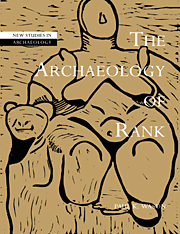Book contents
- Frontmatter
- Contents
- List of figures and tables
- Acknowledgments
- 1 The present study of past society
- 2 Social theory and social life: models of society in the archaeological study of status
- 3 Inequality and social life: a working model
- 4 Mortuary data as evidence of ranking, Part 1
- 5 Mortuary data as evidence of ranking, Part 2
- 6 The form and distribution of artifacts
- 7 Status, settlements, and structures
- 8 Çatal Hüyük: a ranked Neolithic town in Anatolia?
- Notes
- References
- Index
- NEW STUDIES IN ARCHAEOLOGY
8 - Çatal Hüyük: a ranked Neolithic town in Anatolia?
Published online by Cambridge University Press: 22 August 2009
- Frontmatter
- Contents
- List of figures and tables
- Acknowledgments
- 1 The present study of past society
- 2 Social theory and social life: models of society in the archaeological study of status
- 3 Inequality and social life: a working model
- 4 Mortuary data as evidence of ranking, Part 1
- 5 Mortuary data as evidence of ranking, Part 2
- 6 The form and distribution of artifacts
- 7 Status, settlements, and structures
- 8 Çatal Hüyük: a ranked Neolithic town in Anatolia?
- Notes
- References
- Index
- NEW STUDIES IN ARCHAEOLOGY
Summary
Bold, mysterious, and endlessly fascinating, a few ancient monuments have profoundly shaped our understanding of the past, becoming, indeed, household words. Çatal Hüyük is not among these. But if not quite a Stonehenge or Machu Picchu in the popular imagination, Çatal Hüyük is in many ways just as striking, disturbing, enigmatic. And its singular importance for prehistory has not been lost on archaeologists, who have long appreciated the extraordinary social and intellectual life that flourished here nine millennia in the past. The great murals of Çatal Hüyük have not yet aroused fantastical theories and tabloid revelations, nor have they entered the twentieth-century imagination so deeply as the cave paintings of Lascaux. But the site holds a fascination for archaeologists and other scholars of the early history of humanity which remains undiminished since excavations began, an interest, I expect, that will only grow as we ask ever more personal questions of the lives of early humans.
A precocious settlement and well preserved, Çatal Hüyük offers a vibrant picture of creativity and passion in the Early Neolithic, an era otherwise largely obscured by the passing of more than eighty centuries. The unmistakable humanity revealed here is all the more striking for the fact that excavated levels date from perhaps 7,500 to 6,700 BC in calendar years. And yet, whether despite or because of the range of material preserved, this settlement remains somehow inscrutable and alien. The expressive art in particular leaves us feeling that we almost know what was going on here.
- Type
- Chapter
- Information
- The Archaeology of Rank , pp. 153 - 179Publisher: Cambridge University PressPrint publication year: 1994



